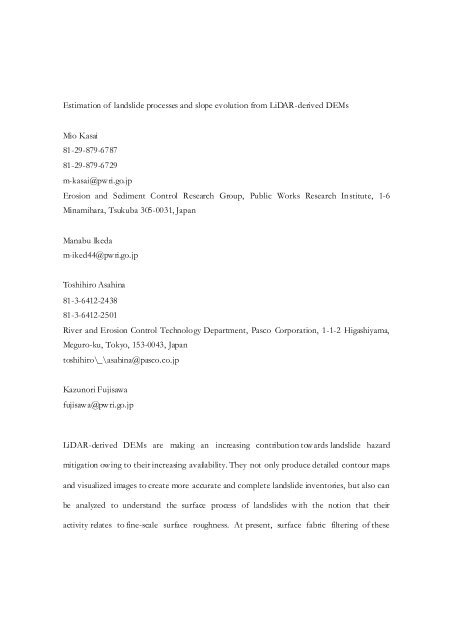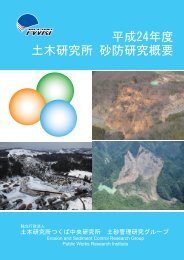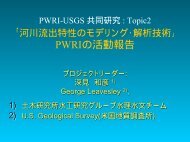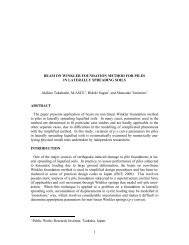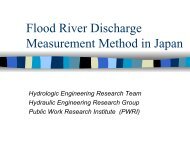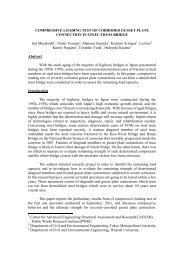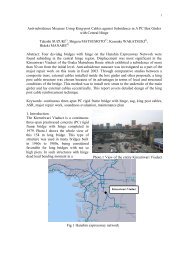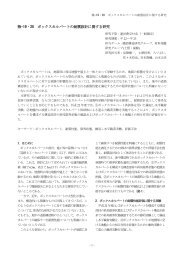Estimation of landslide processes and slope evolution from LiDAR ...
Estimation of landslide processes and slope evolution from LiDAR ...
Estimation of landslide processes and slope evolution from LiDAR ...
You also want an ePaper? Increase the reach of your titles
YUMPU automatically turns print PDFs into web optimized ePapers that Google loves.
<strong>Estimation</strong> <strong>of</strong> <strong>l<strong>and</strong>slide</strong> <strong>processes</strong> <strong>and</strong> <strong>slope</strong> <strong>evolution</strong> <strong>from</strong> <strong>LiDAR</strong>-derived DEMs<br />
Mio Kasai<br />
81-29-879-6787<br />
81-29-879-6729<br />
m-kasai@pwri.go.jp<br />
Erosion <strong>and</strong> Sediment Control Research Group, Public Works Research Institute, 1-6<br />
Minamihara, Tsukuba 305-0031, Japan<br />
Manabu Ikeda<br />
m-iked44@pwri.go.jp<br />
Toshihiro Asahina<br />
81-3-6412-2438<br />
81-3-6412-2501<br />
River <strong>and</strong> Erosion Control Technology Department, Pasco Corporation, 1-1-2 Higashiyama,<br />
Meguro-ku, Tokyo, 153-0043, Japan<br />
toshihiro\_\asahina@pasco.co.jp<br />
Kazunori Fujisawa<br />
fujisawa@pwri.go.jp<br />
<strong>LiDAR</strong>-derived DEMs are making an increasing contribution towards <strong>l<strong>and</strong>slide</strong> hazard<br />
mitigation owing to their increasing availability. They not only produce detailed contour maps<br />
<strong>and</strong> visualized images to create more accurate <strong>and</strong> complete <strong>l<strong>and</strong>slide</strong> inventories, but also can<br />
be analyzed to underst<strong>and</strong> the surface process <strong>of</strong> <strong>l<strong>and</strong>slide</strong>s with the notion that their<br />
activity relates to fine-scale surface roughness. At present, surface fabric filtering <strong>of</strong> these
DEMs has been used to examine individual <strong>l<strong>and</strong>slide</strong>s, although <strong>l<strong>and</strong>slide</strong> <strong>processes</strong> can be<br />
better understood when they are considered as a part <strong>of</strong> hill<strong>slope</strong> <strong>evolution</strong> <strong>of</strong> the area <strong>of</strong><br />
interest. This presentation introduces the work that the eigenvalue ratio, which represents the<br />
3-dimensional surface roughness, can be used to analyze <strong>l<strong>and</strong>slide</strong> <strong>processes</strong> <strong>and</strong> their<br />
influence on hill<strong>slope</strong> <strong>evolution</strong>. A case study is presented <strong>from</strong> a 5 km 2 steep (average <strong>slope</strong> =<br />
36 \%) area <strong>of</strong> Kii Peninsula, Japan, where a 1-m grid <strong>LiDAR</strong>-derived DEM was used to<br />
derive eigenvalue ratios <strong>and</strong> related terrain attributes. The <strong>slope</strong>s <strong>of</strong> the v-shaped valleys are<br />
particularly <strong>l<strong>and</strong>slide</strong>-prone <strong>and</strong> there is little valley margin except for occasional terraces along<br />
the river.<br />
Based on a combination <strong>of</strong> the eigenvalue ratio <strong>and</strong> field survey, the <strong>slope</strong>s <strong>of</strong> the study area<br />
were categorized into 4 principal types. Slopes with a filter value <strong>of</strong> less than 2.50 (roughest)<br />
are bedrock-dominant, while those between 2.50 <strong>and</strong> 2.75 partly represent surface<br />
collapses <strong>and</strong> loosened bedrock, <strong>and</strong> those between 2.75 <strong>and</strong> 3.00 are colluvial <strong>slope</strong>s with<br />
large rock materials. Where the value exceeds 3.00 the <strong>slope</strong>s are inactive or covered with fine<br />
colluvial materials. The results imply that more attention should be paid to <strong>l<strong>and</strong>slide</strong><br />
blocks with a filter value <strong>of</strong> between 2.50 <strong>and</strong> 2.75, e.g. by continuous monitoring, as they are<br />
at higher risk <strong>of</strong> entire <strong>slope</strong> collapse in the near future. The eigenvalue ratio tends to increase<br />
<strong>and</strong> the terrain becomes smoother uphill, indicating that <strong>slope</strong>s evolve by losing stability <strong>from</strong><br />
the valley floor. The blocks with a value between 2.75 <strong>and</strong> 3.00 may in future gain similar <strong>slope</strong><br />
features to those with a value between 2.50 <strong>and</strong> 2.75, although how long this transition takes is<br />
uncertain. The process has probably been driven by the river eroding the base <strong>of</strong> hill<strong>slope</strong>s <strong>and</strong><br />
striping away earth at high flows.
The results suggest that, not only can the current activity <strong>of</strong> <strong>l<strong>and</strong>slide</strong>s be evaluated, but also<br />
their future behavior can be estimated by applying surface fabric filters to an area <strong>of</strong> interest<br />
<strong>and</strong> considering their spatial distribution. Together with creating detailed <strong>l<strong>and</strong>slide</strong> inventories,<br />
utilizing <strong>LiDAR</strong>-derived DEMs in this manner will in future contribute to the planning<br />
<strong>of</strong> <strong>l<strong>and</strong>slide</strong> hazard mitigation programs.


